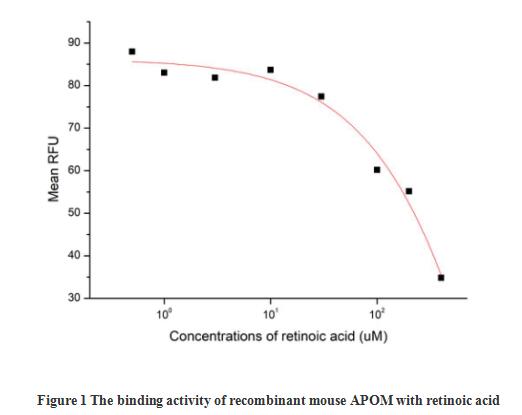Active Apolipoprotein M (APOM)
Apo-M; G3a; NG20; Protein G3a
- Product No.UAPC299Mu01
- Organism SpeciesMus musculus (Mouse) Same name, Different species.
- Buffer FormulationPBS, pH7.4, containing 0.01% SKL, 5% Trehalose.
- TraitsFreeze-dried powder
- Purity> 95%
- Isoelectric Point5.9
- ApplicationsCell culture; Activity Assays.
- Download Instruction Manual
- UOM 10µg50µg 200µg 1mg 5mg
-
FOB
US$ 96
For more details, please contact local distributors!US$ 240
For more details, please contact local distributors! US$ 480
For more details, please contact local distributors! US$ 1440
For more details, please contact local distributors! US$ 3600
For more details, please contact local distributors!
ACTIVITY TEST of the Active Apolipoprotein M (APOM)

Apolipoprotein M (APOM) is an approximately 25 kDa variably glycosylated protein that adopts a beta-barrel structure characteristic of lipocalin family proteins. It functions as a component of lipoprotein particles which play essential roles in fatty acid and cholesterol transport and metabolism. Alternative splicing generates a short isoform that lacks the N-terminal 72 amino acids. APOM is produced primarily by hepatocytes but also by renal tubule epithelial cells. The signal peptide is not cleaved and is required for APOM association with lipoprotein particles as well as Megalin mediated reabsorption by the kidney. The activity of recombinant mouse APOM was measured by its ability to bind all-trans retinoic acid. The binding of retinoic acid results in the quenching of Trp fluorescence in APOM. APOM was diluted to 50 ug/ml in 50 mM Tris, 10 mM CaCl2, 150 mM NaCl, pH 7.5 (assay buffer) and the retinoic acid was diluted to 400, 200, 100, 30, 10, 3, 1 and 0.5 µM in 95% ethanol. Mixing 112.5 µL of 50 µg/mL rmAPOM and 12.5 µL of retinoic acid serial dilutions in microtubes and a blank containing 112.5 µL of 50 µg/mL rmAPOM and 12.5 µL of 95% ethanol, then incubate at room temperature for 30 minutes. Loading 100 ul of the reaction mixtures and blank and read at excitation and emission wavelengths of 280 nm and 340 nm (top read), respectively, in endpoint mode. The result was shown in figure 1, the 50% binding concentration (BC50) is >300 µM.
USAGE of the Active Apolipoprotein M (APOM)
Reconstitute in 10mM PBS (pH7.4) to a concentration of 0.1-1.0 mg/mL. Do not vortex.
STORAGE of the Active Apolipoprotein M (APOM)
Avoid repeated freeze/thaw cycles. Store at 2-8°C for one month. Aliquot and store at -80°C for 12 months.
STABILITY of the Active Apolipoprotein M (APOM)
The thermal stability is described by the loss rate. The loss rate was determined by accelerated thermal degradation test, that is, incubate the protein at 37°C for 48h, and no obvious degradation and precipitation were observed. The loss rate is less than 5% within the expiration date under appropriate storage condition.
INCREMENT SERVICES
BCA Protein Quantification Kit
Molecular Mass Marker for Protein
Monoclonal Antibody Customized Service
Polyclonal Antibody Customized Service
Protein Activity Test Experiment Service
Electrophoretic Mobility Shift Assay (EMSA) Experiment Service
Buffer
Lentivirus Packaging Experiment Service
Adenovirus Packaging Experiment Service
Real Time PCR Experimental Service
Spike RBD Protein (S-RBD)
Protein G
Protein A
Related products
| Catalog No. | Organism species: Mus musculus (Mouse) | Applications (RESEARCH USE ONLY!) |
| URPC299Mu01 | Recombinant Apolipoprotein M (APOM) | Positive Control; Immunogen; SDS-PAGE; WB. |
| UAPC299Mu01 | Active Apolipoprotein M (APOM) | Cell culture; Activity Assays. |
| UPAC299Mu01 | Polyclonal Antibody to Apolipoprotein M (APOM) | WB |
| ULAC299Mu71 | Biotin-Linked Polyclonal Antibody to Apolipoprotein M (APOM) | WB |
| USEC299Mu | ELISA Kit for Apolipoprotein M (APOM) | Enzyme-linked immunosorbent assay for Antigen Detection. |
| ULMC299Mu | Multiplex Assay Kit for Apolipoprotein M (APOM) ,etc. by FLIA (Flow Luminescence Immunoassay) | FLIA Kit for Antigen Detection. |



